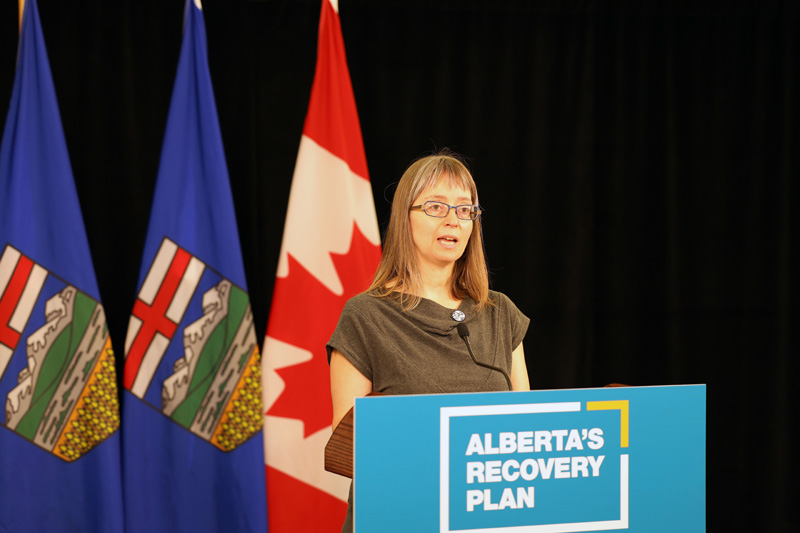The government of Alberta announced on Aug. 4 the use of non-medical face masks will be mandatory for grade 4 to 12 students for the upcoming 2020-21 school year.
“After completing our review of current evidence, I’m now recommending that non-medical masks be worn by staff, teachers, and students in grades 4 and above in Alberta,” said the Chief Medical Officer of Health, Dr. Deena Hinshaw.
“This means that when classes begin this fall, masks will be mandatory for students in grades 4 through 12, and all staff and teachers outside the classroom, or when activities inside the classroom involve close interactions,” she said.
Mask use is required while students and staff are in common areas outside of the classroom such as hallways and school buses, or when maintaining a physical distance of two metres is not possible.
“Masks are not required inside the classroom when students are seated and the teacher is distanced from the students, though they can still be worn if a student and teacher choose,” Hinshaw said.
Hinshaw and her team have discussed different options for arranging students’ desks to ensure a two-metre distance can be maintained, and students won’t be facing each other.
“If two metres cannot be maintained, the pros and cons of mask-wearing in a classroom setting where instruction is happening need to be weighed out very carefully,” Hinshaw said.
“If students or teachers are interacting in a way that’s close and involve them working together, then mask-wearing is expected,” she added. “If students are seated in their desks, working quietly and not moving around and the teacher is distanced from them then mask-wearing is optional in that setting.”
School staff are required to wear a mask in all settings where physical distancing cannot be maintained.
However, mask use for kindergarten to grade 3 students will continue to be optional, as mask use for younger children can be challenging due to difficulties with proper fit, and compliance.
“There is growing evidence that wearing non-medical masks can interrupt transmission in public indoor spaces including school settings with older children,” Hinshaw said.
“The safety, and the well-being of our staff and our students has been and continues to be my number one priority,” said the Minister of Education, Adriana LaGrange.
“Emerging evidence has made it clear that masks can play an important role in limiting the spread of COVID-19 in our schools,” LaGrange said.
School boards, teachers, staff, and parents are not expected to endure the financial burden that is associated with the new rule, as the government of Alberta will provide every kindergarten to grade 12 students with two reusable masks.
“This will ensure that students who are required to wear masks, will have them, and will allow for kindergarten to grade 3 students to have masks should they wish to wear them,” LaGrange said.
Single-use masks will also be available at schools in the event that students or staff misplace their own.
More than 1.6 million reusable masks will be provided to 740,000 students and 90,000 staff across the province.
Teachers, support staff, and bus drivers will also be provided with one reusable face shield for use in schools.
The use of face shields will be at the discretion of the individual staff member.
“While face shields can help reduce exposure, they are not equivalent to masks. That is why staff who choose to wear a face shield will still be required to wear a mask,” LaGrange said.
In addition to the use of masks, two contactless thermometers will be provided to every school.
“Thermometer use will be at the discretion of the school authority, and will assist with managing student and staff health,” LaGrange said.
All supplies will be distributed to school authorities prior to the start of the 2020-21 school year.
To help reduce absences Alberta Education, and Alberta Health Services (AHS) is exploring the possibility of expanding testing capacity to reduce turnaround times for testing school staff, teachers, and students.
“We will also continue to work with school authorities to ensure they have the support they need and are well equipped for a safe and successful return to school,” LaGrange said.
“Our guidelines for school re-entry will continue to evolve to ensure they reflect the most up-to-date medical advice,” she said.
The decision to make mask use mandatory was made through reviews of evidence from jurisdictions around the world.
“Since day one, we have committed to acting on the best evidence available at any given time. This means not relying on a single study or jurisdictions experience but methodically assessing all of the evidence available and acting on that information,” Hinshaw said.
Hinshaw believes that requiring masks for all school staff and students from grade 4 and above is an essential step to limiting the spread of COVID-19 within schools and protecting the health of everyone.
“We know that masks can be an effective addition to reducing COVID-19 transmission when used properly, and we also know that schools are unique settings, where special measures are needed to mitigate the risks of exposure,” Hinshaw said.
However, Hinshaw reminds Albertans that masks are only one part of the public health approach being implemented in schools.
“Masks alone do not keep schools and students safe from COVID-19. No single precaution of public health measure will eliminate all risks of exposure in schools or any other setting,” Hinshaw said.
“Physical distancing, cohorting, frequent handwashing, enhanced cleaning and changes to how classes and schools operate are equally as important in limiting the spread of the virus in schools. There is still no risk-free approach in living with COVID-19, we have no choice but to live with it,” she said.
Adding, “Everyone in the school community will have to do their part and follow public health guidance to keep each other safe.”
If needed, the government of Alberta will continue to update the public health advice for schools based on the best available evidence.
“This is part of living in the new normal of COVID-19, we must be agile, adaptive, and guided by the evidence as it emerges,” Hinshaw said.
“This is the best way to protect the health and wellbeing of students, staff, families, and communities,” she said.









